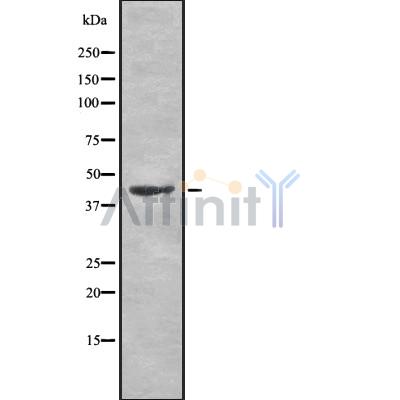GPR109A/B Antibody - #DF10281
| Product: | GPR109A/B Antibody |
| Catalog: | DF10281 |
| Description: | Rabbit polyclonal antibody to GPR109A/B |
| Application: | WB IF/ICC |
| Reactivity: | Human |
| Mol.Wt.: | 43 kDa; 42kD,44kD(Calculated). |
| Uniprot: | Q8TDS4 | P49019 |
| RRID: | AB_2840859 |
Product Info
*The optimal dilutions should be determined by the end user.
*Tips:
WB: For western blot detection of denatured protein samples. IHC: For immunohistochemical detection of paraffin sections (IHC-p) or frozen sections (IHC-f) of tissue samples. IF/ICC: For immunofluorescence detection of cell samples. ELISA(peptide): For ELISA detection of antigenic peptide.
Cite Format: Affinity Biosciences Cat# DF10281, RRID:AB_2840859.
Fold/Unfold
G protein coupled receptor 109A; G protein coupled receptor HM74a; G protein coupled receptor Hm74b; G-protein coupled receptor 109A; G-protein coupled receptor HM74A; G109A_HUMAN; GPR 109A; Gpr109a; GPR109A protein; HCA2; HCAR2; HM 74; HM 74a; HM 74b; Hm74; HM74a; HM74b; hydroxycarboxylic acid receptor 2; Interferon gamma inducible gene Puma g; Niacin receptor 1; NIACR1; Nicotinic acid receptor 1; Nicotinic acid receptor; Protein upregulated in macrophages by IFNG, mouse, homolog of; Puma g; Pumag; rHM74b; G protein coupled receptor 109B; G protein coupled receptor HM74; G protein coupled receptor HM74B; G-protein coupled receptor 109B; G-protein coupled receptor HM74; G-protein coupled receptor HM74B; GPR109B; HCA3; HCAR3; HCAR3_HUMAN; HM74; HM74B; Hydroxycarboxylic acid receptor 3; Niacin receptor 2; NIACR2; Nicotinic acid receptor 2; Puma g; PUMAG;
Immunogens
A synthesized peptide derived from human GPR109A/B, corresponding to a region within C-terminal amino acids.
Expression largely restricted to adipose tissue and spleen. Expressed on mature neutrophils but not on immature neutrophils or eosinophils.
P49019 HCAR3_HUMAN:Expression largely restricted to adipose tissue and spleen.
- Q8TDS4 HCAR2_HUMAN:
- Protein BLAST With
- NCBI/
- ExPASy/
- Uniprot
MNRHHLQDHFLEIDKKNCCVFRDDFIVKVLPPVLGLEFIFGLLGNGLALWIFCFHLKSWKSSRIFLFNLAVADFLLIICLPFLMDNYVRRWDWKFGDIPCRLMLFMLAMNRQGSIIFLTVVAVDRYFRVVHPHHALNKISNRTAAIISCLLWGITIGLTVHLLKKKMPIQNGGANLCSSFSICHTFQWHEAMFLLEFFLPLGIILFCSARIIWSLRQRQMDRHAKIKRAITFIMVVAIVFVICFLPSVVVRIRIFWLLHTSGTQNCEVYRSVDLAFFITLSFTYMNSMLDPVVYYFSSPSFPNFFSTLINRCLQRKMTGEPDNNRSTSVELTGDPNKTRGAPEALMANSGEPWSPSYLGPTSP
- P49019 HCAR3_HUMAN:
- Protein BLAST With
- NCBI/
- ExPASy/
- Uniprot
MNRHHLQDHFLEIDKKNCCVFRDDFIAKVLPPVLGLEFIFGLLGNGLALWIFCFHLKSWKSSRIFLFNLAVADFLLIICLPFVMDYYVRRSDWKFGDIPCRLVLFMFAMNRQGSIIFLTVVAVDRYFRVVHPHHALNKISNWTAAIISCLLWGITVGLTVHLLKKKLLIQNGTANVCISFSICHTFRWHEAMFLLEFFLPLGIILFCSARIIWSLRQRQMDRHAKIKRAITFIMVVAIVFVICFLPSVVVRIHIFWLLHTSGTQNCEVYRSVDLAFFITLSFTYMNSMLDPVVYYFSSPSFPNFFSTLINRCLQRKITGEPDNNRSTSVELTGDPNKTRGAPEALIANSGEPWSPSYLGPTSNNHSKKGHCHQEPASLEKQLGCCIE
Research Backgrounds
Acts as a high affinity receptor for both nicotinic acid (also known as niacin) and (D)-beta-hydroxybutyrate and mediates increased adiponectin secretion and decreased lipolysis through G(i)-protein-mediated inhibition of adenylyl cyclase. This pharmacological effect requires nicotinic acid doses that are much higher than those provided by a normal diet. Mediates nicotinic acid-induced apoptosis in mature neutrophils. Receptor activation by nicotinic acid results in reduced cAMP levels which may affect activity of cAMP-dependent protein kinase A and phosphorylation of target proteins, leading to neutrophil apoptosis. The rank order of potency for the displacement of nicotinic acid binding is 5-methyl pyrazole-3-carboxylic acid = pyridine-3-acetic acid > acifran > 5-methyl nicotinic acid = acipimox >> nicotinuric acid = nicotinamide.
Cell membrane>Multi-pass membrane protein.
Expression largely restricted to adipose tissue and spleen. Expressed on mature neutrophils but not on immature neutrophils or eosinophils.
Belongs to the G-protein coupled receptor 1 family.
Receptor for 3-OH-octanoid acid mediates a negative feedback regulation of adipocyte lipolysis to counteract prolipolytic influences under conditions of physiological or pathological increases in beta-oxidation rates. Acts as a low affinity receptor for nicotinic acid. This pharmacological effect requires nicotinic acid doses that are much higher than those provided by a normal diet.
Cell membrane>Multi-pass membrane protein.
Expression largely restricted to adipose tissue and spleen.
Belongs to the G-protein coupled receptor 1 family.
Research Fields
· Environmental Information Processing > Signal transduction > cAMP signaling pathway. (View pathway)
Restrictive clause
Affinity Biosciences tests all products strictly. Citations are provided as a resource for additional applications that have not been validated by Affinity Biosciences. Please choose the appropriate format for each application and consult Materials and Methods sections for additional details about the use of any product in these publications.
For Research Use Only.
Not for use in diagnostic or therapeutic procedures. Not for resale. Not for distribution without written consent. Affinity Biosciences will not be held responsible for patent infringement or other violations that may occur with the use of our products. Affinity Biosciences, Affinity Biosciences Logo and all other trademarks are the property of Affinity Biosciences LTD.

